khan academy's UX design
November 9, 2022

(Revised December 2, 2022)
Though I have been a longtime user of Khan Academy, I have never taken the time to closely analyze Khan Academy’s UX design. Upon further examination, it appears that Khan Academy has an overall good UX design as it successfully meets the user’s needs, is sufficiently user-friendly, and pleasantly customizes the user’s experience.
Khan Academy caters to many different groups, whether that be students who use the platform to supplement what they have learned in class to users who take advantage of the platform for self-improvement and curiosity. Other groups of users include high school students preparing for standardized tests (AP, SAT, ACT, etc.) as well as teachers. From my personal experience, I would say that Khan Academy does a relatively good job of meeting the different needs of all these users. When I was younger, I would occasionally use Khan Academy to learn new skills and I found the system straightforward to operate even as a kid; it was easy to track my progress and I did not have to worry about planning out my own curriculum. In high school, Khan Academy’s videos and articles were extremely helpful for my AP classes, and their practice SAT tests were an incredibly valuable tool as well. Finally, though I cannot fully speak on behalf of my teachers, I noticed that my teachers would often show us Khan Academy videos in class or provide us with Khan Academy links that we could explore optionally.
Khan Academy is user-friendly as it is simple to navigate even if a user has never been on the platform previously. It guides first-time users through the sign-up process, asking them different questions so it understands what type of content they are looking for. Users can view the different courses they are taking as well as track their progress through the “mastery” percentage. Furthermore, the site is readily accessible as users can search for courses or specific topics with ease.
Khan Academy allows users to choose their own courses, enabling users to personalize their learning experience. Once a user is taking a course, they can jump from section to section, so they do not have to learn everything in sequential order. Moreover, users do not have to take the quizzes if they do not wish to do so. Thus, the user does not feel constrained nor pressured in any manner when taking a new course.
Once a user completes a quiz, the website displays a cute visual effect with confetti and an encouraging message to congratulate the user. If the user has completed certain activities or reached a specific milestone, they are rewarded with badges. Users gain energy points after watching a video or finishing a quiz, providing a sense of accomplishment. These energy points can also be used to unlock new avatars, which “gamifies” the learning process and incentivizes users to keep learning through the platform.
Overall, while Khan Academy has a solid UX design, there are some minor tweaks the company could make to improve the user experience. The website currently has a drop-down menu where the user can view all the courses offered on the site. As the site has grown over the years and now has many different courses available, the drop-down menu is incredibly large–it fills up the entire page–and is potentially overwhelming and confusing to first-time users. Khan Academy should instead attempt to streamline the site’s resources to users in a more organized manner. Additionally, Khan Academy could provide some sort of road map for each subject to better guide users in their learning journey and self-study curriculum planning. Finally, Khan Academy should implement different color themes; the most popularly requested one is a dark theme, which would allow users to study more effectively and comfortably at night.